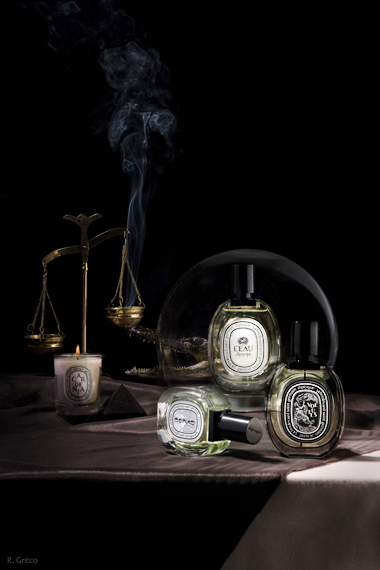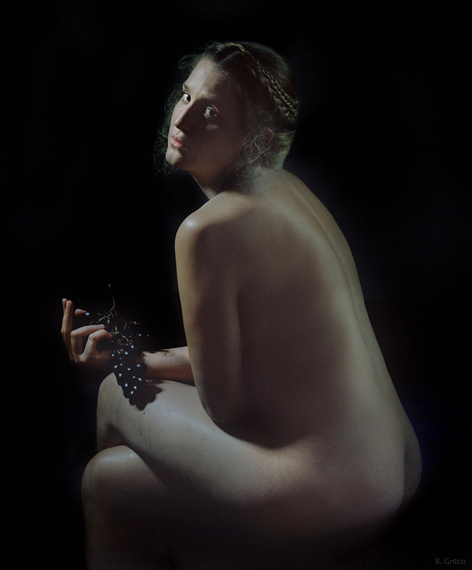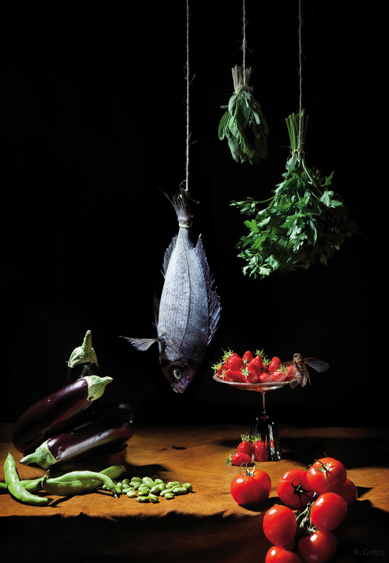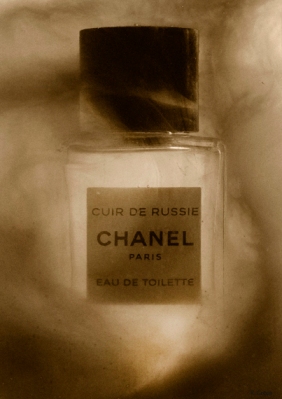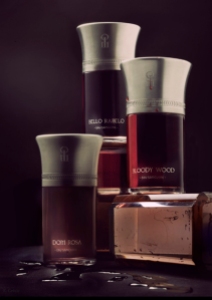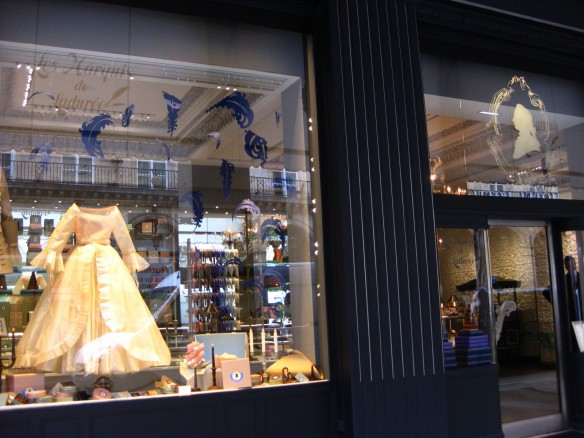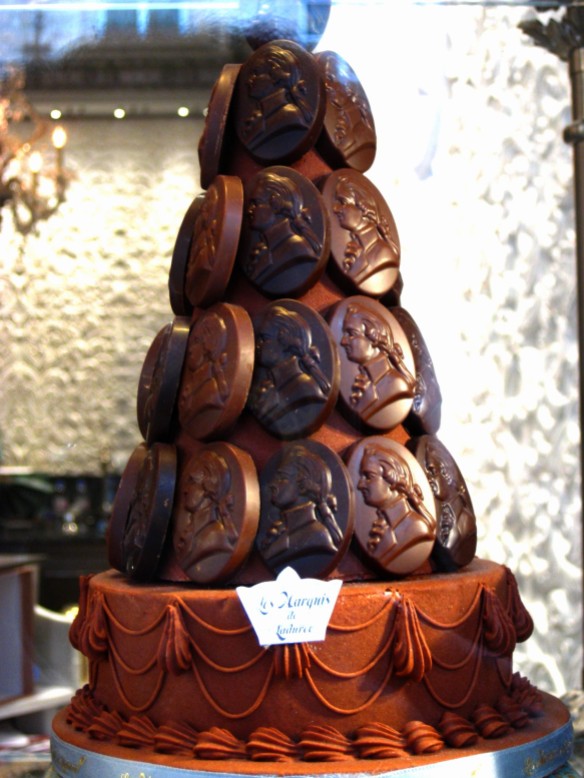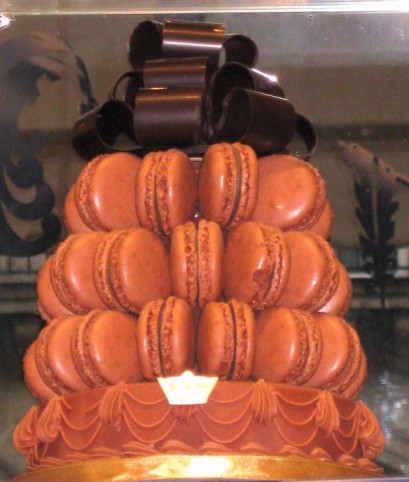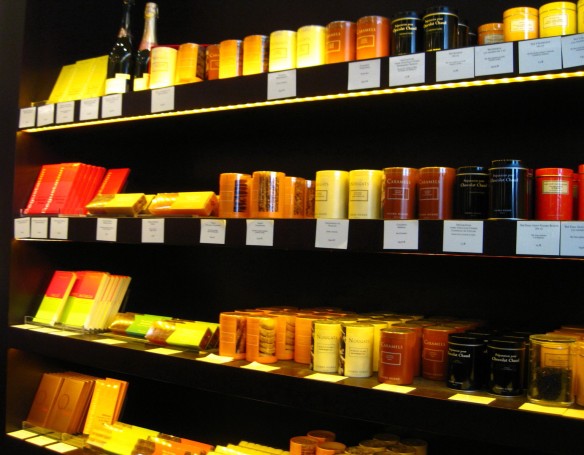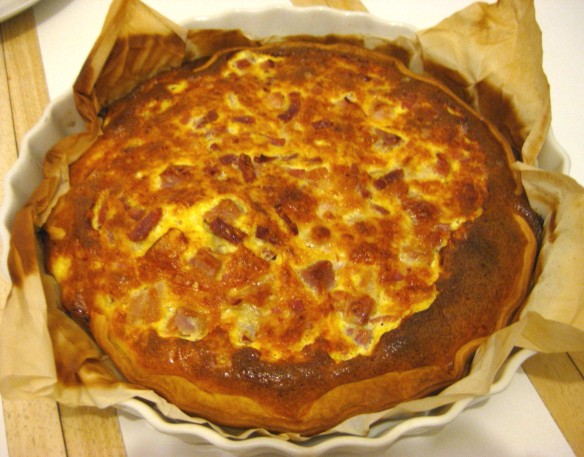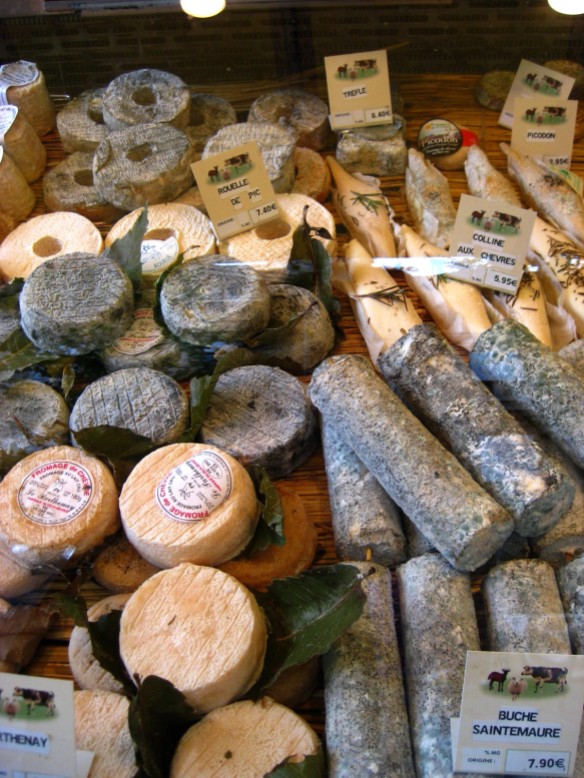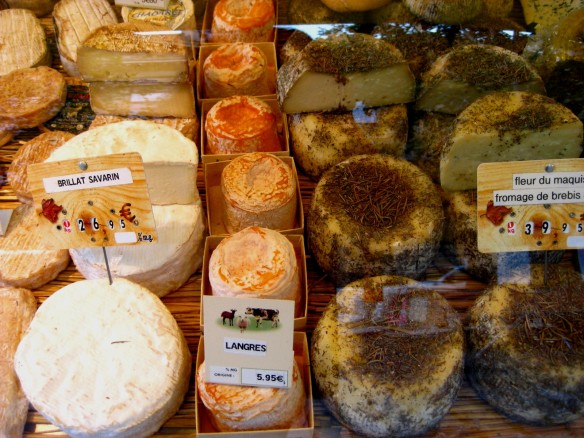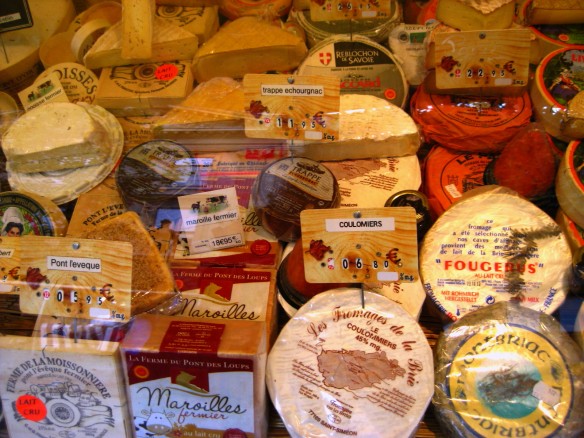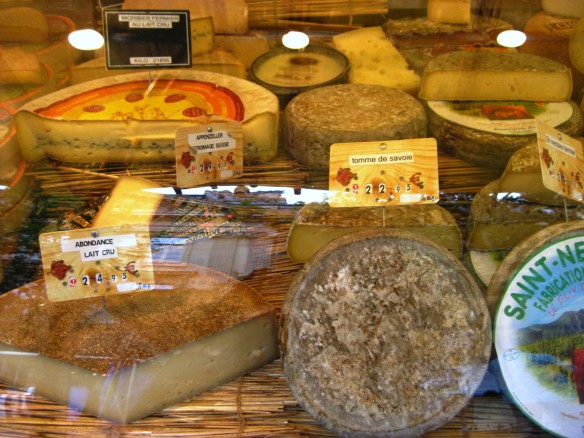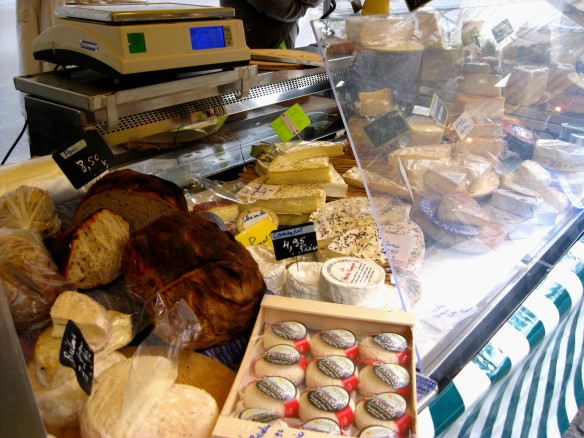Life is better when one’s joys are shared with friends. I firmly believe that. I simply enjoy things more when I feel as though friends are exploring, tasting, seeing, or feeling things with me. For that reason, I fear this post is going to be a very long one, visually, because I have a lot of photos of Paris. A lot!
You all know Paris is a magical city, but I love its quirky side just as much as its majestic one. There is so much that I hope you can enjoy along with me, even if none of it is particularly significant on a grand level: bridge railings covered with locks given as a declaration of love; Golden Retrievers hanging out at the gardens of the Louvre; the statue of St. Antoine in the St. Germain church where people write message or prayers on his actual figure; people chilling at the Tuileries before interesting sculptures; a media frenzy near the Palais Royal (that temporarily blocked me from going to Serge Lutens) because of some important meeting with government and/or cabinet ministers; exuberant street performers or quirky shops in Le Marais, the old Jewish quarter; the glitz of jewels at Le Place Vendome; the strangely eye-catching, ugly beauty of the modernistic Pompidou Museum; those sitting by the Seine in quiet contemplation one cloudy afternoon; the feel of a variety of cafés throughout the city; and so much more.
Let’s start with the river Seine. I love walking along side it, peeking into the street stalls with their colourful, touristy postcards and posters. Sometimes, one can find some treasures in the occasional stall dealing with rare books, or offering old vinyl LPs. Usually though, my eye is always caught by the early 20th century or art deco art that is immortalized on the postcards. I adore the Toulouse-Lautrec posters that are usually featured, or the gaiety of old Josephine Baker cards. So here are some photos taken on the Right Bank, along with some images of people simply sitting by the Seine and enjoying the view. (You can click on the thumbnail to expand it.)
I’d been walking by the river when I looked up and saw the closest bridge had tons of shiny, golden objects on the railings. I can’t recall now which bridge it was (and I don’t think it was the Pont Neuf), but I decided to explore. It turns out that every inch of railing was festooned with locks. Even parts of the bronze lamps on the bridge were covered in them! In the back of my mind, I had a vague memory of my high school years and how some of the students would hang locks on gates with their initials and those of a loved one. It’s basically a declaration of love and commitment, that your love will stand steadfast and firm like a lock. Much like a squirrel drawn to shiny things, I became obsessed with taking photos of these things — and the street musician who was playing before one of them didn’t seem to mind being included in the picture.
I’m not generally one who will go into raptures about gardens, but the Jardin des Tuileries is a whole other story. I’m a sucker for beautifully manicured, formal gardens, done on the vastest scale imaginable. As a little bit of context for why the Tuileries are special, I thought I’d quote some of its history and features from an informational website:
The Tuileries Gardens get their name from the tile factories which previously stood on the site where Queen Catherine de Medici built the Palais des Tuileries in 1564. The famous gardener of King Louis XIV, André Le Nôtre, re-landscaped the gardens in 1664 to give them their current French formal garden style. The gardens, which separate the Louvre from the Place de la Concorde, are a cultural walking place for Parisians and tourists where Maillol statues stand alongside those of Rodin or Giacometti. The gardens’ two ponds are perfect for relaxation. The Musée de l’Orangerie, where visitors can admire the works of Monet, is located south-west of Tuileries.
Sadly, none of my photos do the Tuileries any justice whatsoever. Absolutely none. (Stupid, tiny camera! Stupid, stupid thing!) What I loved the most were the acres of people just chilling, many lounging on a chair with their feet up on another, and reading a book or chatting with a friend. Others spent time people-watching, while children played at a big fountain with large toy sailboats that you could rent. One fountain was lovely in the late afternoon, with eye-catching light shining through the dark clouds. It was odd, though, to see three policemen questioning a man seated in one of the many chairs before it. There was a vast trail of water all around him, and leading in a path to the fountain. His clothes didn’t look sopping wet, but that water seemed to tell a very different tale. And I would swear from the conversation that I partially overheard that the policemen were threatening to take him in because this was the third time that he’d gone into the fountain!

A view of the Louvre from the gardens.

Chilling on the grass in the area between the Louvre and the Tuilerie gardens.

The statue up close.

From another angle.

People just hanging out, many with their feet up.

A chap renting large, toy sailboats to use in one of the fountains.

One of the long walkways in the Tuleries.

The fountain that the man supposedly went into!
The Tuileries are a stones throw away from the Louvre, and one thing that caught my eye were the dog owners hanging out with their furry children. Now, my particular canine obsession involves German shepherds, but who can resist a fuzzy face?! These boys get their own individual slot and close-up!



Once you get to the Louvre itself, it’s really hard to know where to look. While the grandeur of the baroque architecture speaks for itself, the enormity of it all is utterly overwhelming and screams out, “I am FRANCE! Bow down before my majesty!” I’ve not only been to Paris before, I used to live there on four different occasions, and it still takes my breath away. It always will. The simple fact is that things like this cannot be done without the wealth and resources created by an extremely feudal system. And all one can do is to thank God that even the Nazis were so overwhelmed by Paris, that they left its beauty intact. Legend has it that one of the German generals, General Dietrich von Choltitz, refused Hitler’s direct orders to bomb Paris on the eve of the Liberation. I won’t get into the historical debate on the veracity of that legend, but let’s just be glad Paris’ splendours remain intact. So, here is a glimpse at the Louvre in the late afternoon near closing time, including a peek inside and down the main pyramid:

Hanging out before the pyramid.

Near closing time, but still a bit crowded.

Where you’d line up for buy tickets to go into the Louvre.

Just one end and part of the Louvre in length!

Looking down inside the main Louvre pyramid at the people below.

Early evening.
At the complete other end of the aesthetic and architectural spectrum is the Pompidou Museum. Frankly, I’ve always thought it unbelievably hideous! Yet, if you really look at it, it’s an oddly entrancing symphony of hideousness. Or perhaps you simply can’t stop looking at its revolting…. well, I’m not sure what term would really suit it best. Still, you cannot deny that this epitome of ’70s modernity is one of a kind. (I rather think that’s a good thing.). Officially entitled Le Centre George Pompidou, it is France’s national modern art museum, and enormously significant. As one Paris tourist site, The Paris Pass, explains:
The Centre Pompidou is Europe’s most important museum of modern art and one of the worlds most significant art galleries.
Some of the art movements represented within the Pompidou Center are Fauvism, Cubism, Surrealism and Abstract Expressionism. It has 50,000 works of art (including paintings, sculpture, drawings, and photography), of which 1,500 to 2,000 are on display to the visitors of this National Museum of Modern Art.
The building’s design is somewhat contentious but undeniably unique, distinctive, and increasingly appreciated by all who see it. […]
The fourth and fifth floors of the Centre Pompidou are home to the Musée National d’Art Moderne, one of the major international collections of modern art located in Paris. It includes works by artists such as Kandinsky, Matisse, Miró, and Picasso.
You can read up on its design history at Wikipedia if you’re interested, but I’ll just quote their description of people’s reaction to the museum when it first debuted:
National Geographic described the reaction to the design as “love at second sight.”[3] An article in Le Figaro declared “Paris has its own monster, just like the one in Loch Ness.” But two decades later, while reporting on Rogers’ winning the Pritzker Prize in 2007, The New York Times noted that the design of the Centre “turned the architecture world upside down” and that “Mr. Rogers earned a reputation as a high-tech iconoclast with the completion of the 1977 Pompidou Centre, with its exposed skeleton of brightly coloured tubes for mechanical systems. The Pritzker jury said the Pompidou “revolutionized museums, transforming what had once been elite monuments into popular places of social and cultural exchange, woven into the heart of the city.”.[4] […]
Initially, all of the functional structural elements of the building were colour-coded: green pipes are plumbing, blue ducts are for climate control, electrical wires are encased in yellow, and circulation elements and devices for safety (e.g., fire extinguishers) are red.[1]
That Loch Ness line is my favorite! What often interests me about the Pompidou Center is the life outside it. A long, slightly upwardly slope of stony ground is before it, and people just sit to chat or, in some cases, as you will see in one photo below, to kiss. The area around the museum is called Beaubourg, and it’s full of life, from cafés to cinemas, to busy cyclists on one of the many rental bikes you can get across the city. I walked around one early evening near sunset and took photos:

One side of the Pompidou.

The front of the Pompidou, towards the top.

Roy Lichtenstein exhibit being advertised.

The top of the slightly sloping wall or ground.

A kiss at sunset.

A small sidestreet near the museum.

Another street with cafés filling up at night.

Twilight at Beaubourg.

Rental bicycles are widely available throughout Paris. They always have lots of lights and safety neon.
Going all around Paris is pretty easy to do with the metro, though it takes a little bit of time to adjust to the system. Once you do, however, it’s rather straight forward, and buying a “carnet” (or book) of 10 tickets (at a discounted rate) encourages you to really explore. Thanks to the metro, I went all over. One day, it was the chic St. Germain district on the Left Bank, where you come out of the metro very close to the church that I used to go to quite a bit as a child. L’Eglise St. Germain is the oldest church in Paris, with parts that date back to the 6th century, and I always loved its darkened comfort as a child. For some reason that I can no longer remember, I’d always been rather fascinated with St. Antoine, or St. Anthony of Padua, the patron saint of lost things (or lost causes). The established ritual in that church was that you would write your wishes on his statue — and I was incredibly happy to see that the tradition still continued to this day.
Across the street from the church is its spiritual polar opposite: a Louis Vuitton store before which, on the day I visited, was parked a Bentley with Monegasque (or Monaco) license plates. Next to the Louis Vuitton is another example of elitist luxury that St. Antoine would probably have frowned heavily upon: the exclusive, trendy Hotel Costes’-owned restaurant called La Societé. Diagonally across from the Church and to the left of the block is the Les Deux Magots (pronounced as Mah-Goh) café and its bitter rival, the Café Flore. These two adjacent cafés are very famous, and have quite a rich history:
Both Café de Flore and Café Les Deux Magots first opened in the late 19th century. It is said that Jean Paul Sartre and Simone de Beauvoir discussed existentialism at Café de Flore, while Ernest Hemingway and Pablo Picasso preferred Les Deux Magots.
Café de Flore sits on the corner of Boulevard Saint-Germain and the Rue St. Benoit. The art deco interior, with red leather banquettes and polished mahogany, has changed little over the years. During the Occupation of World War II, it is said that the Germans preferred Deux Magots, so many of the writers moved to Flore, where they were kept warm in winter by the large stove that still sits in the middle of the room.
Equally relevant for historical reasons is another literary haunt on the opposite side of the St. Germain boulevard: the famous Brasserie Lipp. With its original 1926 Art Deco decor and its Alsace comfort food, “Le Lipp” had once been the home away from home of artists, writers, intellectuals and politicians alike. Like Les Deux Magots and Café Flore, it’s not always to get a table. As one site explains:
There’s no use phoning for a table at the Brasserie Lipp – they won’t reserve one, unless you are the Prime Minister of France. Like everyone else, you will have to stand around and wait: it’s part of the Lipp ritual. […] If it is any consolation, it is even more difficult to become a waiter at the Brasserie Lipp – you have to be proposed.
When you do get in, however, you stand a good chance of eating next to the many celebrities who frequent Brasserie Lipp. Marcel Proust used to send for jugs of the Alsatian beer from across town, Hemingway wrote his pre-war dispatches from here, and in the Fifties Chagall, Camus, Jean Genet, Balthus, Michèle Morgan, Françoise Sagan, Charles Trenet and Simone Signoret with Yves Montand were all regular habitués of this famous establishment. Late President François Mitterand was one of Lipp’s inner circle as well as Harrison Ford, Gérard Depardieu, Gregory Peck and President Jacques Chirac when he was Mayor of Paris.
Below are some photos from the Left Bank (in thumbnail form that you can expand), including a few photos from the Place St. Sulpice whose fountain has four statues surrounded by lions. Each statue is of a famous, 17th century French bishop who was renowned for his eloquence:

Les Deux Magots, diagonally opposite the St. Germain church.

Right opposite the church, LV & a Bentley. I don’t think St. Antoine would approve.

St. Antoine’s statue inside the church with all the writing on it.

A close up of the writing.

An adorable little balcony with its plants and a single creeping vine.

St. Sulpice fountain showing Fléchier

St. Sulpice in St. Germain.
There were different destinations on other days. Once, it was the Place Vendome where I peered at the windows of various jewellery stores (and got one shot of one extravagantly expensive, bejewelled necklace that was from Dior, I think). Another time, it was a church on the Rue St. Honoré that I revisited for nostalgic reasons. Then, there was a walk past l’Opera with its spectacular facade. One night, I had dinner with friends near one of the canals in Paris, le Canal St. Martin, near the Place de la Republique. Once, I even ended up at the far end of Paris, at La Defense, where I took photos of the interesting buildings and two colourful sculptures. On another occasion, it was the turn of Le Marais, the old Jewish quarter that is now filled with art galleries. There, I walked part the National Archives to an adorable square filled with cafés where I saw street performers doing acrobatics. At the Marais’ local, “quartier” version of “city hall” (at least, I think it was that), I saw a large photo of Nelson Mandela posted on the top of the building, and suddenly had the terrible fear that he may have died. I think they had posted it in support of his ill health, and in hopes that he improve.

L’Opera

One part of l’Opera.

Le Place Vendome.

Chanel at Le Place Vendome.

Chanel’s jewellery window at Le Place Vendome. Photo: my own.

A jewelled necklace from Dior, I think, at the Place Vendome.

Sculpture at La Defense

One of the buildings at La Defense.

Nelson Mandela photo at the top of the building in Le Marais.

National Archives

Canal St. Martin at night

Place de la Republique

Street performers in Le Marais

The small square in Le Marais with its cafés.

Adorable shop in Le Marais which sold nothing but glasses for Absinthe.
Then, there was my attempt to go back to the Serge Lutens mothership after I had finally made up my mind on which bell jar (or two) to get. (It’s still a secret, until I post about it.) At Les Palais Royal, my every attempt to get to Serge Lutens was foiled by massive security and a frenzy of media. I’m still not quite sure precisely what was going on, but it was apparently some important meeting on a legislative matter and attended by government officials and cabinet ministers. All I know is that the French media can be quite rabid to get their stories, and that there were a lot of formally garbed individuals in uniform or sporting a medallion necklace of their office. Finally, all the fuss died down, the police became less sternly grumpy, and I was permitted to go through to get my “Precioussssssss” (™ Hajusuuri).
On another occasion, I spent an afternoon at a café on the Ile St. Louis, near Notre Dame, with two friends. I was supposed to meet one of them first at Notre Dame, specifically in the middle of one of its bridges, but we had a rather amusing game of miscommunication because Notre Dame has several! As I waited, I took photos of the magnificent structure which, in 2012, began a year-long celebration of its 850th birthday!
While there is just so much to the city that is spectacular or that worms its way into your heart, Paris has changed a lot since my times there — and not always for the better. For example, I find the Champs-Élysées to be one of the most depressing places in the whole city with its Las Vegas-style displays; the tacky bling of its enormous high-end shops contrasted with the cheapness or gaudiness of the large stores at the other extreme; and the complete loss of all its intimate, personal, charming individuality. I actually did my best to avoid the area entirely if possible; I remembered all too well how a visit a few years before had left me nearly in tears at the of the drastic, sharp changes. Another area of Paris, near Port Maillot where people get the Air France buses to Charles de Gaulle, had utterly horrified me with its grime, street litter, and dirtiness. Even the beautiful white or cream stone buildings that I remember in some upper-class neighborhoods looked dark with grime. The dog poo on the streets was much less than it used to be — though one Parisienne I know strongly disagrees — but the city could do with a good scrubbing in some parts.
Money, however, is very tight, and the new government is raising taxes to quite a degree. Everywhere I went, people were talking about the taxes. From taxi drivers, to shop keepers, to strangers conversing on the metro, to wealthy friends of mine, there was incredible frustration, bitterness, or a feeling of “enough is enough” in the air. I may be getting the exact percentages somewhat wrong by a point or two, but I recall one person who is a professional mentioning a tax rate of 48%, while a corporate entrepreneur said his company was taxed at 63%. Whatever the precise figures, they are high, and left me just blinking. (I do not want to discuss politics on the blog, as it never — ever — ends well and only will cause a fight, so please let’s not go in that direction.) I bring up the issue only to try to explain why Paris may not have the money to do what it needs to on an aesthetic basis. On a happier note, as I hope this series has demonstrated, there is still enormous loveliness to be found, in both the tourist spots and in small little corners.
I’m sure I’ve thoroughly exhausted you with all these photos, and for that I apologise. But, it’s Paris, dammit, and this is only the tip of the its beautiful iceberg! Joking aside, if you’re exhausted, why don’t you pull up a chair at one of Paris’ many cafés, and enjoy a glass of wine. It will be a good aperitif for all the food porn photos (and cheese!) that will await you in Part III. That post, with its singular focus on Paris food, chocolates, street markets, and more, should be up in a day or two.

Blurry, I know, but I loved the colours of this photo.







